Management 1 Report: WL Gore & Associates Approach Analysis
VerifiedAdded on 2023/01/17
|14
|3802
|77
Report
AI Summary
This report provides a comprehensive analysis of the management approach employed by W.L. Gore & Associates, focusing on its distinctive lattice organizational structure. It examines the key features of this structure, including the absence of formal leadership positions, the emphasis on peer-to-peer communication, and the self-management system. The report delves into the leadership style within Gore, where influence and ability, rather than formal titles, determine leadership roles. It explores the company's core beliefs and guiding principles, such as the power of small teams, individual accountability, and long-term focus, and how these principles contribute to the company's culture of innovation and employee engagement. The report also evaluates the advantages and disadvantages of Gore's approach, highlighting its flexibility, adaptability, and high employee retention, while also acknowledging potential challenges related to role clarity and management control. Finally, it assesses the transferability of Gore's management model to other companies, considering the types of organizations that might benefit from adopting a similar approach.
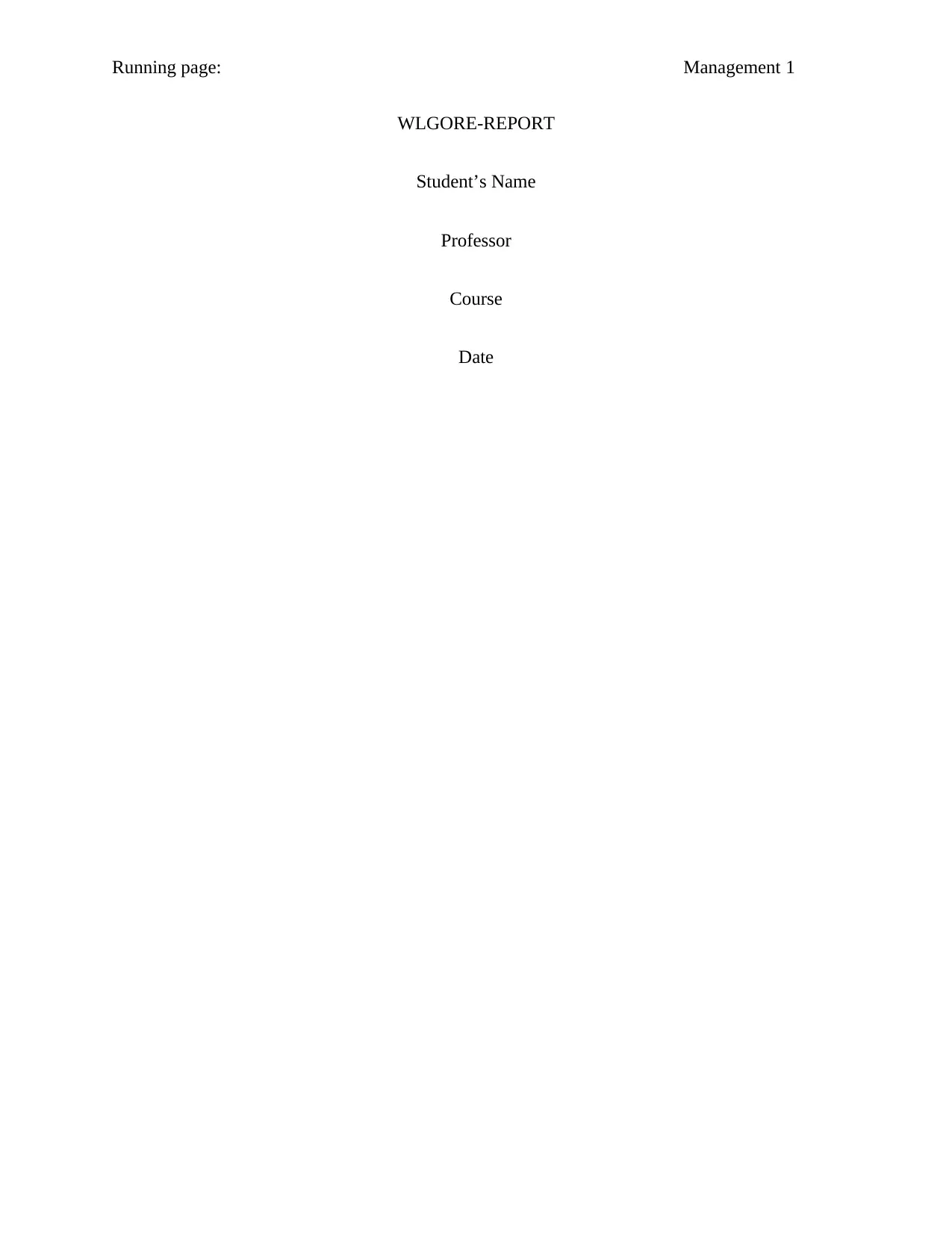
Running page: Management 1
WLGORE-REPORT
Student’s Name
Professor
Course
Date
WLGORE-REPORT
Student’s Name
Professor
Course
Date
Paraphrase This Document
Need a fresh take? Get an instant paraphrase of this document with our AI Paraphraser
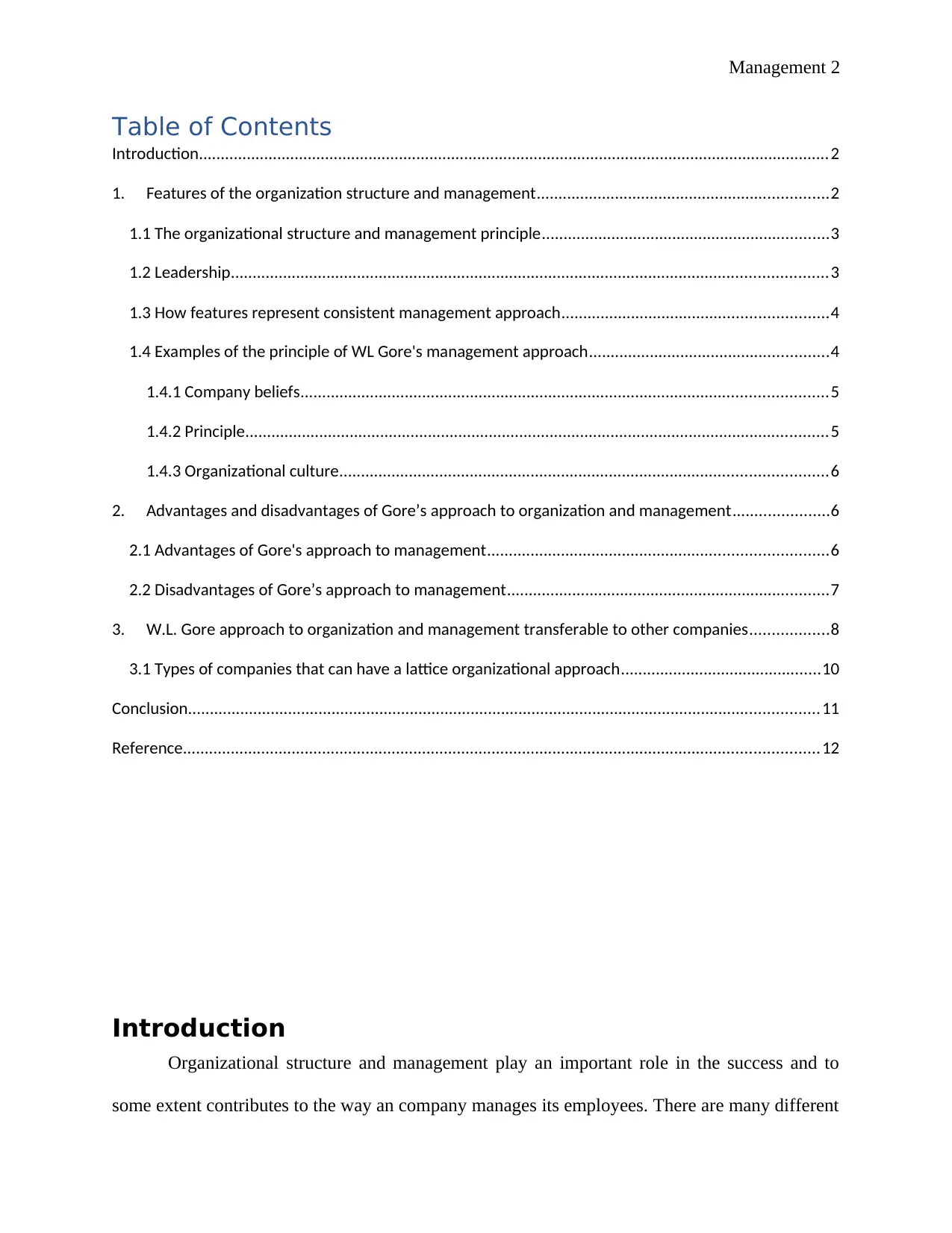
Management 2
Table of Contents
Introduction.................................................................................................................................................2
1. Features of the organization structure and management...................................................................2
1.1 The organizational structure and management principle..................................................................3
1.2 Leadership.........................................................................................................................................3
1.3 How features represent consistent management approach.............................................................4
1.4 Examples of the principle of WL Gore's management approach.......................................................4
1.4.1 Company beliefs.........................................................................................................................5
1.4.2 Principle......................................................................................................................................5
1.4.3 Organizational culture................................................................................................................6
2. Advantages and disadvantages of Gore’s approach to organization and management......................6
2.1 Advantages of Gore's approach to management..............................................................................6
2.2 Disadvantages of Gore’s approach to management..........................................................................7
3. W.L. Gore approach to organization and management transferable to other companies..................8
3.1 Types of companies that can have a lattice organizational approach..............................................10
Conclusion.................................................................................................................................................11
Reference..................................................................................................................................................12
Introduction
Organizational structure and management play an important role in the success and to
some extent contributes to the way an company manages its employees. There are many different
Table of Contents
Introduction.................................................................................................................................................2
1. Features of the organization structure and management...................................................................2
1.1 The organizational structure and management principle..................................................................3
1.2 Leadership.........................................................................................................................................3
1.3 How features represent consistent management approach.............................................................4
1.4 Examples of the principle of WL Gore's management approach.......................................................4
1.4.1 Company beliefs.........................................................................................................................5
1.4.2 Principle......................................................................................................................................5
1.4.3 Organizational culture................................................................................................................6
2. Advantages and disadvantages of Gore’s approach to organization and management......................6
2.1 Advantages of Gore's approach to management..............................................................................6
2.2 Disadvantages of Gore’s approach to management..........................................................................7
3. W.L. Gore approach to organization and management transferable to other companies..................8
3.1 Types of companies that can have a lattice organizational approach..............................................10
Conclusion.................................................................................................................................................11
Reference..................................................................................................................................................12
Introduction
Organizational structure and management play an important role in the success and to
some extent contributes to the way an company manages its employees. There are many different
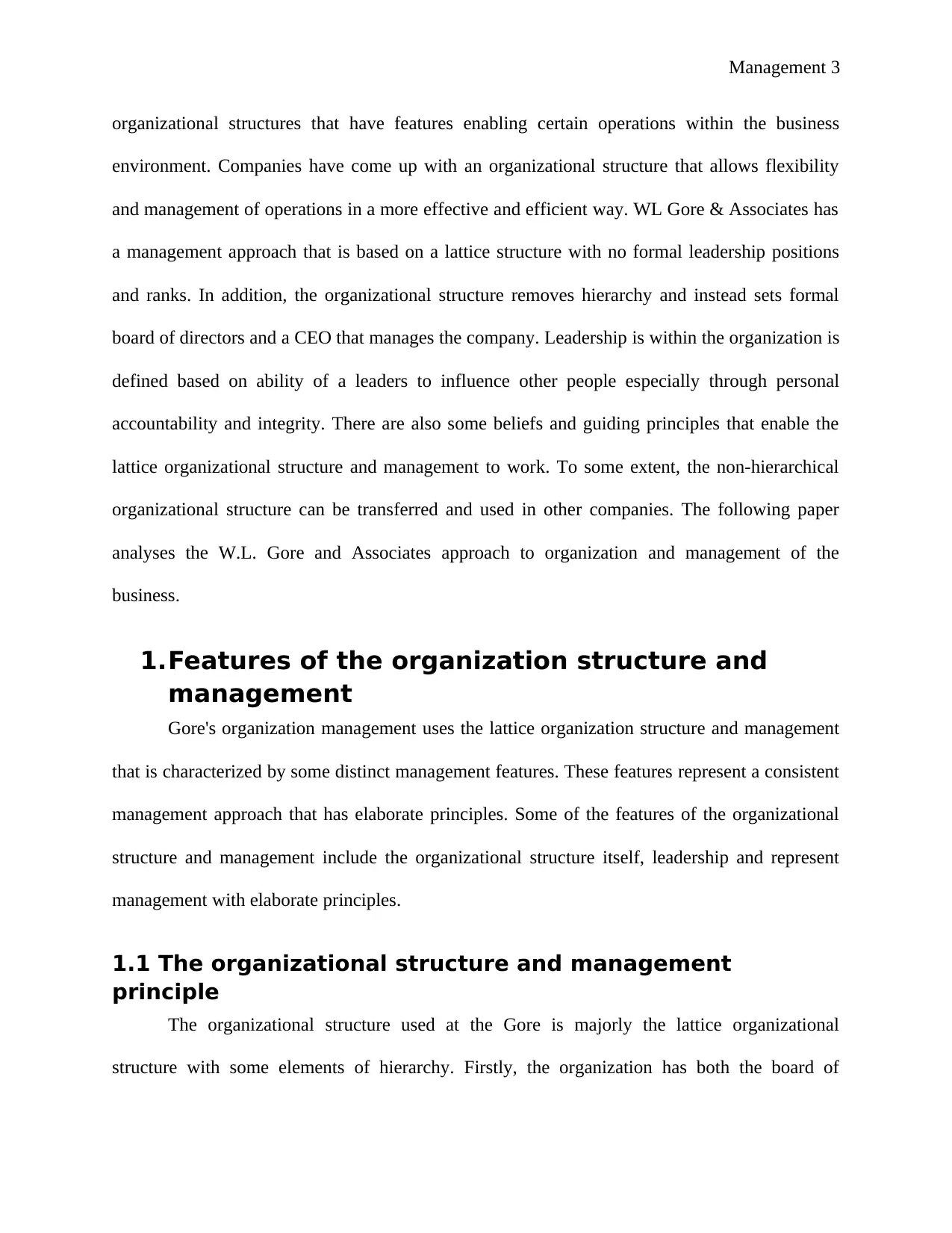
Management 3
organizational structures that have features enabling certain operations within the business
environment. Companies have come up with an organizational structure that allows flexibility
and management of operations in a more effective and efficient way. WL Gore & Associates has
a management approach that is based on a lattice structure with no formal leadership positions
and ranks. In addition, the organizational structure removes hierarchy and instead sets formal
board of directors and a CEO that manages the company. Leadership is within the organization is
defined based on ability of a leaders to influence other people especially through personal
accountability and integrity. There are also some beliefs and guiding principles that enable the
lattice organizational structure and management to work. To some extent, the non-hierarchical
organizational structure can be transferred and used in other companies. The following paper
analyses the W.L. Gore and Associates approach to organization and management of the
business.
1.Features of the organization structure and
management
Gore's organization management uses the lattice organization structure and management
that is characterized by some distinct management features. These features represent a consistent
management approach that has elaborate principles. Some of the features of the organizational
structure and management include the organizational structure itself, leadership and represent
management with elaborate principles.
1.1 The organizational structure and management
principle
The organizational structure used at the Gore is majorly the lattice organizational
structure with some elements of hierarchy. Firstly, the organization has both the board of
organizational structures that have features enabling certain operations within the business
environment. Companies have come up with an organizational structure that allows flexibility
and management of operations in a more effective and efficient way. WL Gore & Associates has
a management approach that is based on a lattice structure with no formal leadership positions
and ranks. In addition, the organizational structure removes hierarchy and instead sets formal
board of directors and a CEO that manages the company. Leadership is within the organization is
defined based on ability of a leaders to influence other people especially through personal
accountability and integrity. There are also some beliefs and guiding principles that enable the
lattice organizational structure and management to work. To some extent, the non-hierarchical
organizational structure can be transferred and used in other companies. The following paper
analyses the W.L. Gore and Associates approach to organization and management of the
business.
1.Features of the organization structure and
management
Gore's organization management uses the lattice organization structure and management
that is characterized by some distinct management features. These features represent a consistent
management approach that has elaborate principles. Some of the features of the organizational
structure and management include the organizational structure itself, leadership and represent
management with elaborate principles.
1.1 The organizational structure and management
principle
The organizational structure used at the Gore is majorly the lattice organizational
structure with some elements of hierarchy. Firstly, the organization has both the board of
⊘ This is a preview!⊘
Do you want full access?
Subscribe today to unlock all pages.

Trusted by 1+ million students worldwide

Management 4
directors and CEO for formality as required of an organization. Secondly, the organization is
divided into four divisions namely fabrics, medical, industrial, and electronic products with
recognized "leaders". Thirdly, the company has larger departments that play some roles in the
organization and these are human resources management and information technology
departments. Fourthly, the organization has no positions or ranks but instead has a self-
management system where people manage themselves. The communication system within the
business is majorly peers to peer as opposed to the normal communication channel of senior
management to subordinate staffs. Lastly, the compensation within the business is based on the
ranking in terms of contribution to the company. Employees are compensated based on the
ranking that is derived from the associate’s contribution within the organization and this
motivates associates to work harder and get high contribution ranking (Kapoor 2012).
1.2 Leadership
Leadership is another distinctive aspect of the lattice organizational structure and
management that is used by the Gore company. The leadership within the organization is based
on the ability to lead your team. This implies that people who are able to influence other team
members are chosen by the team to lead and those leaders who cannot lead are also dismissed by
the team. Team leaders, therefore, are allowed to make decisions, set goals for the team and lead
meetings of the team. The leadership within the lattice organizational structure is based on the
leaders empowering other employees while at the same time leaders needs to empower
themselves. Furthermore, the key feature of leadership is to create the enabling environment for
people to performs hence leader's performance is determined by the team being led (Tambe
2013).
directors and CEO for formality as required of an organization. Secondly, the organization is
divided into four divisions namely fabrics, medical, industrial, and electronic products with
recognized "leaders". Thirdly, the company has larger departments that play some roles in the
organization and these are human resources management and information technology
departments. Fourthly, the organization has no positions or ranks but instead has a self-
management system where people manage themselves. The communication system within the
business is majorly peers to peer as opposed to the normal communication channel of senior
management to subordinate staffs. Lastly, the compensation within the business is based on the
ranking in terms of contribution to the company. Employees are compensated based on the
ranking that is derived from the associate’s contribution within the organization and this
motivates associates to work harder and get high contribution ranking (Kapoor 2012).
1.2 Leadership
Leadership is another distinctive aspect of the lattice organizational structure and
management that is used by the Gore company. The leadership within the organization is based
on the ability to lead your team. This implies that people who are able to influence other team
members are chosen by the team to lead and those leaders who cannot lead are also dismissed by
the team. Team leaders, therefore, are allowed to make decisions, set goals for the team and lead
meetings of the team. The leadership within the lattice organizational structure is based on the
leaders empowering other employees while at the same time leaders needs to empower
themselves. Furthermore, the key feature of leadership is to create the enabling environment for
people to performs hence leader's performance is determined by the team being led (Tambe
2013).
Paraphrase This Document
Need a fresh take? Get an instant paraphrase of this document with our AI Paraphraser
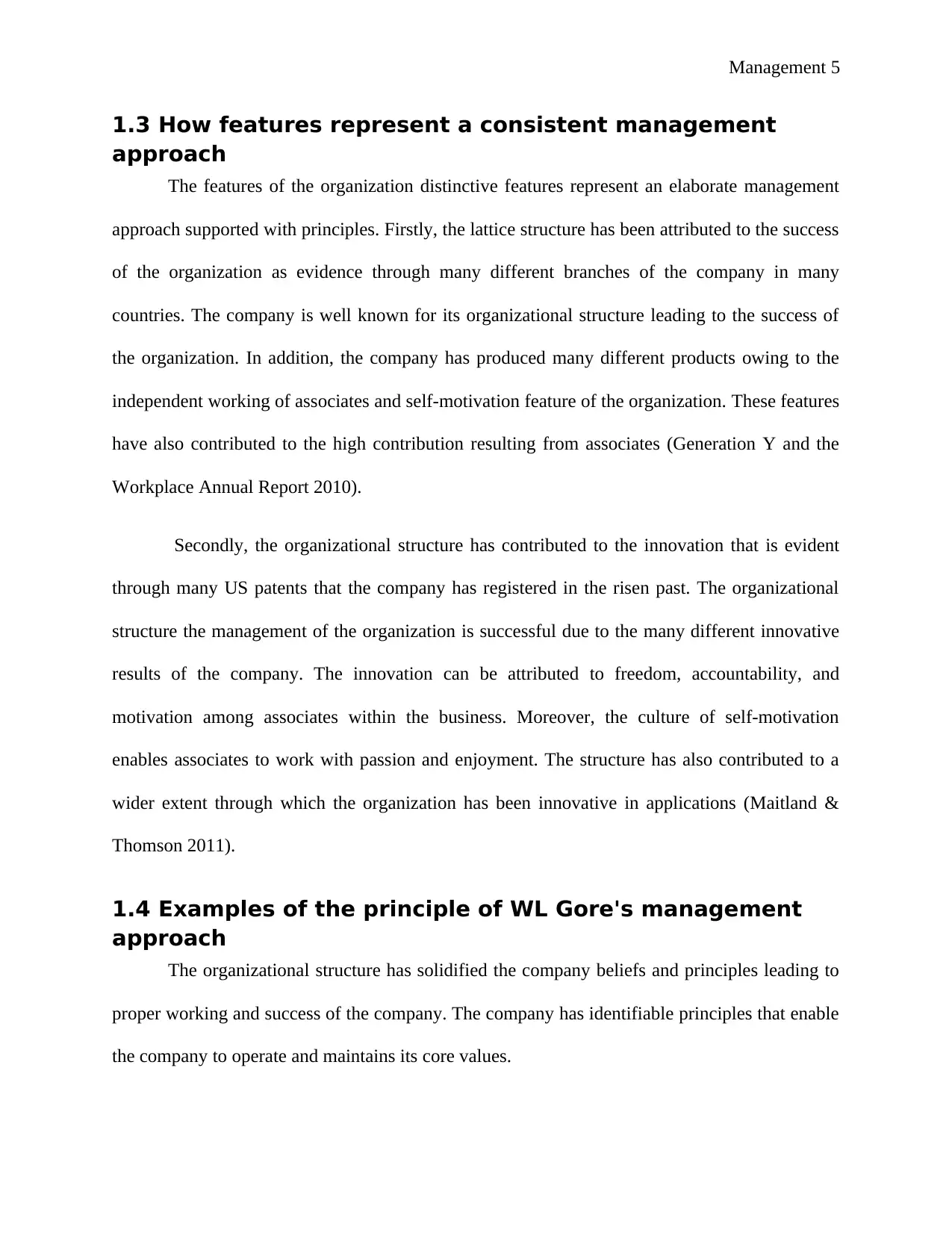
Management 5
1.3 How features represent a consistent management
approach
The features of the organization distinctive features represent an elaborate management
approach supported with principles. Firstly, the lattice structure has been attributed to the success
of the organization as evidence through many different branches of the company in many
countries. The company is well known for its organizational structure leading to the success of
the organization. In addition, the company has produced many different products owing to the
independent working of associates and self-motivation feature of the organization. These features
have also contributed to the high contribution resulting from associates (Generation Y and the
Workplace Annual Report 2010).
Secondly, the organizational structure has contributed to the innovation that is evident
through many US patents that the company has registered in the risen past. The organizational
structure the management of the organization is successful due to the many different innovative
results of the company. The innovation can be attributed to freedom, accountability, and
motivation among associates within the business. Moreover, the culture of self-motivation
enables associates to work with passion and enjoyment. The structure has also contributed to a
wider extent through which the organization has been innovative in applications (Maitland &
Thomson 2011).
1.4 Examples of the principle of WL Gore's management
approach
The organizational structure has solidified the company beliefs and principles leading to
proper working and success of the company. The company has identifiable principles that enable
the company to operate and maintains its core values.
1.3 How features represent a consistent management
approach
The features of the organization distinctive features represent an elaborate management
approach supported with principles. Firstly, the lattice structure has been attributed to the success
of the organization as evidence through many different branches of the company in many
countries. The company is well known for its organizational structure leading to the success of
the organization. In addition, the company has produced many different products owing to the
independent working of associates and self-motivation feature of the organization. These features
have also contributed to the high contribution resulting from associates (Generation Y and the
Workplace Annual Report 2010).
Secondly, the organizational structure has contributed to the innovation that is evident
through many US patents that the company has registered in the risen past. The organizational
structure the management of the organization is successful due to the many different innovative
results of the company. The innovation can be attributed to freedom, accountability, and
motivation among associates within the business. Moreover, the culture of self-motivation
enables associates to work with passion and enjoyment. The structure has also contributed to a
wider extent through which the organization has been innovative in applications (Maitland &
Thomson 2011).
1.4 Examples of the principle of WL Gore's management
approach
The organizational structure has solidified the company beliefs and principles leading to
proper working and success of the company. The company has identifiable principles that enable
the company to operate and maintains its core values.
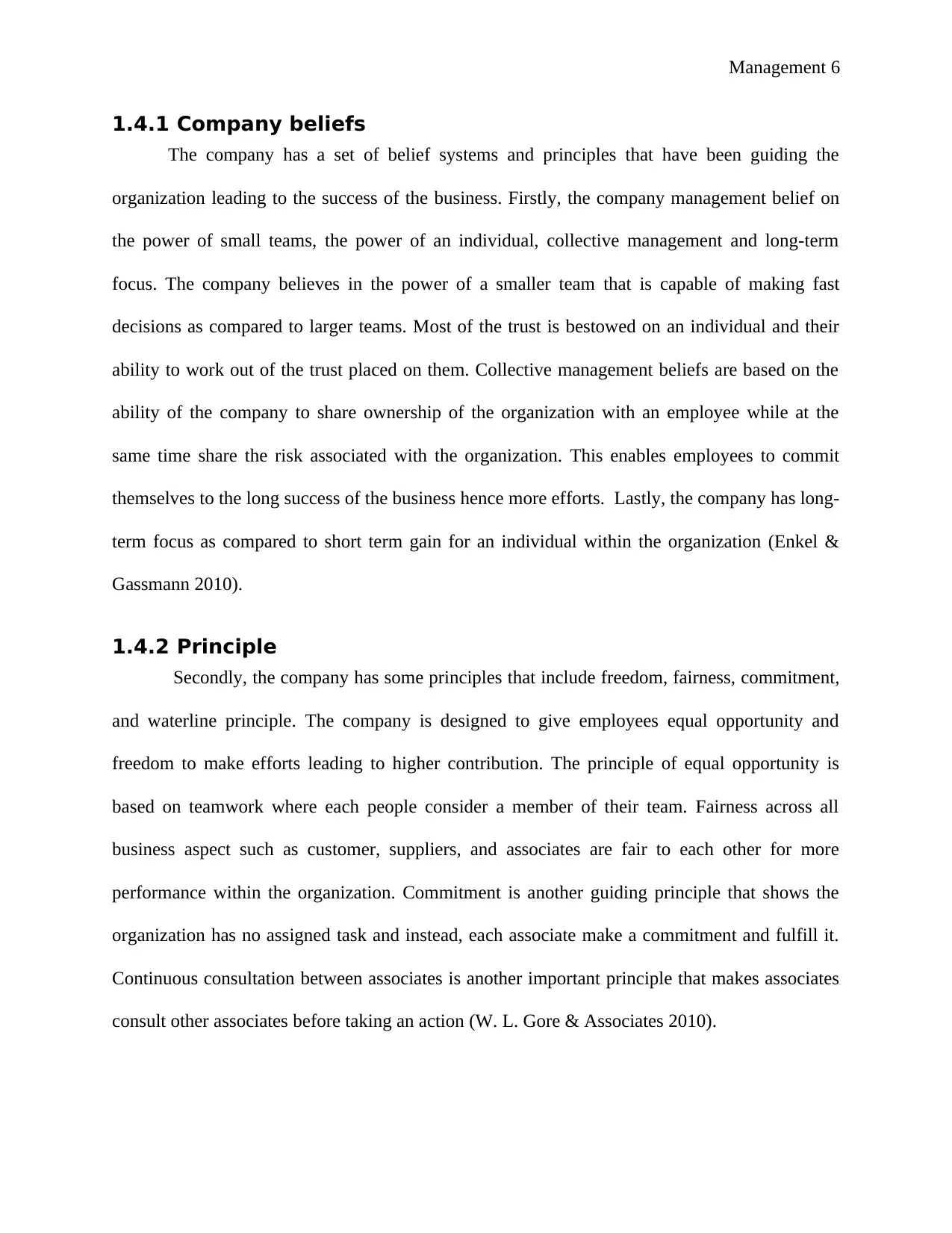
Management 6
1.4.1 Company beliefs
The company has a set of belief systems and principles that have been guiding the
organization leading to the success of the business. Firstly, the company management belief on
the power of small teams, the power of an individual, collective management and long-term
focus. The company believes in the power of a smaller team that is capable of making fast
decisions as compared to larger teams. Most of the trust is bestowed on an individual and their
ability to work out of the trust placed on them. Collective management beliefs are based on the
ability of the company to share ownership of the organization with an employee while at the
same time share the risk associated with the organization. This enables employees to commit
themselves to the long success of the business hence more efforts. Lastly, the company has long-
term focus as compared to short term gain for an individual within the organization (Enkel &
Gassmann 2010).
1.4.2 Principle
Secondly, the company has some principles that include freedom, fairness, commitment,
and waterline principle. The company is designed to give employees equal opportunity and
freedom to make efforts leading to higher contribution. The principle of equal opportunity is
based on teamwork where each people consider a member of their team. Fairness across all
business aspect such as customer, suppliers, and associates are fair to each other for more
performance within the organization. Commitment is another guiding principle that shows the
organization has no assigned task and instead, each associate make a commitment and fulfill it.
Continuous consultation between associates is another important principle that makes associates
consult other associates before taking an action (W. L. Gore & Associates 2010).
1.4.1 Company beliefs
The company has a set of belief systems and principles that have been guiding the
organization leading to the success of the business. Firstly, the company management belief on
the power of small teams, the power of an individual, collective management and long-term
focus. The company believes in the power of a smaller team that is capable of making fast
decisions as compared to larger teams. Most of the trust is bestowed on an individual and their
ability to work out of the trust placed on them. Collective management beliefs are based on the
ability of the company to share ownership of the organization with an employee while at the
same time share the risk associated with the organization. This enables employees to commit
themselves to the long success of the business hence more efforts. Lastly, the company has long-
term focus as compared to short term gain for an individual within the organization (Enkel &
Gassmann 2010).
1.4.2 Principle
Secondly, the company has some principles that include freedom, fairness, commitment,
and waterline principle. The company is designed to give employees equal opportunity and
freedom to make efforts leading to higher contribution. The principle of equal opportunity is
based on teamwork where each people consider a member of their team. Fairness across all
business aspect such as customer, suppliers, and associates are fair to each other for more
performance within the organization. Commitment is another guiding principle that shows the
organization has no assigned task and instead, each associate make a commitment and fulfill it.
Continuous consultation between associates is another important principle that makes associates
consult other associates before taking an action (W. L. Gore & Associates 2010).
⊘ This is a preview!⊘
Do you want full access?
Subscribe today to unlock all pages.

Trusted by 1+ million students worldwide

Management 7
1.4.3 Organizational culture
The organizational structure and management are based on some culture that is based on
working for fun and making money. The company shares collective ownership and management
and this has contributed to the working culture of the organization. The company collective
ownership results in innovation ethics and accountability nature of associates working within the
organization. This enables the organization to realize success attributed to the hard work of
associates as co-owners. Another culture that enables the company to continue performing is the
culture of doing some out of passion. Being passionate about what one is doing enable them to
be self-motivated hence work hard for the success of the organization. The company allows
associates or employees to work out of passion and this creates motivation that is seen on the
success of the organization. The organizational communication which is an important
organizational behavior aspect is mainly through peer to peer communication. This form of
communication allows interaction between employees called associates hence peer to peer
consultation (Baker 2015).
2.Advantages and disadvantages of Gore’s
approach to organization and management
2.1 Advantages of Gore's approach to management
The W.L. Gore approach to organizational management has various advantages to the
employee and the organization itself. The business and management allow flexible and adaptable
to changes in market factors, allow multiple career pathways, take advantage of the talent pool,
greater work retention and high productivity. Firstly, the organization structure and management
allow a greater degree of flexibility since there are no positions and ranks that causes hierarchy
within the company. In addition, the organization is able to change its management structure
based on the need requirement (Puranam 2014). For instance, the leadership of Gore's
1.4.3 Organizational culture
The organizational structure and management are based on some culture that is based on
working for fun and making money. The company shares collective ownership and management
and this has contributed to the working culture of the organization. The company collective
ownership results in innovation ethics and accountability nature of associates working within the
organization. This enables the organization to realize success attributed to the hard work of
associates as co-owners. Another culture that enables the company to continue performing is the
culture of doing some out of passion. Being passionate about what one is doing enable them to
be self-motivated hence work hard for the success of the organization. The company allows
associates or employees to work out of passion and this creates motivation that is seen on the
success of the organization. The organizational communication which is an important
organizational behavior aspect is mainly through peer to peer communication. This form of
communication allows interaction between employees called associates hence peer to peer
consultation (Baker 2015).
2.Advantages and disadvantages of Gore’s
approach to organization and management
2.1 Advantages of Gore's approach to management
The W.L. Gore approach to organizational management has various advantages to the
employee and the organization itself. The business and management allow flexible and adaptable
to changes in market factors, allow multiple career pathways, take advantage of the talent pool,
greater work retention and high productivity. Firstly, the organization structure and management
allow a greater degree of flexibility since there are no positions and ranks that causes hierarchy
within the company. In addition, the organization is able to change its management structure
based on the need requirement (Puranam 2014). For instance, the leadership of Gore's
Paraphrase This Document
Need a fresh take? Get an instant paraphrase of this document with our AI Paraphraser
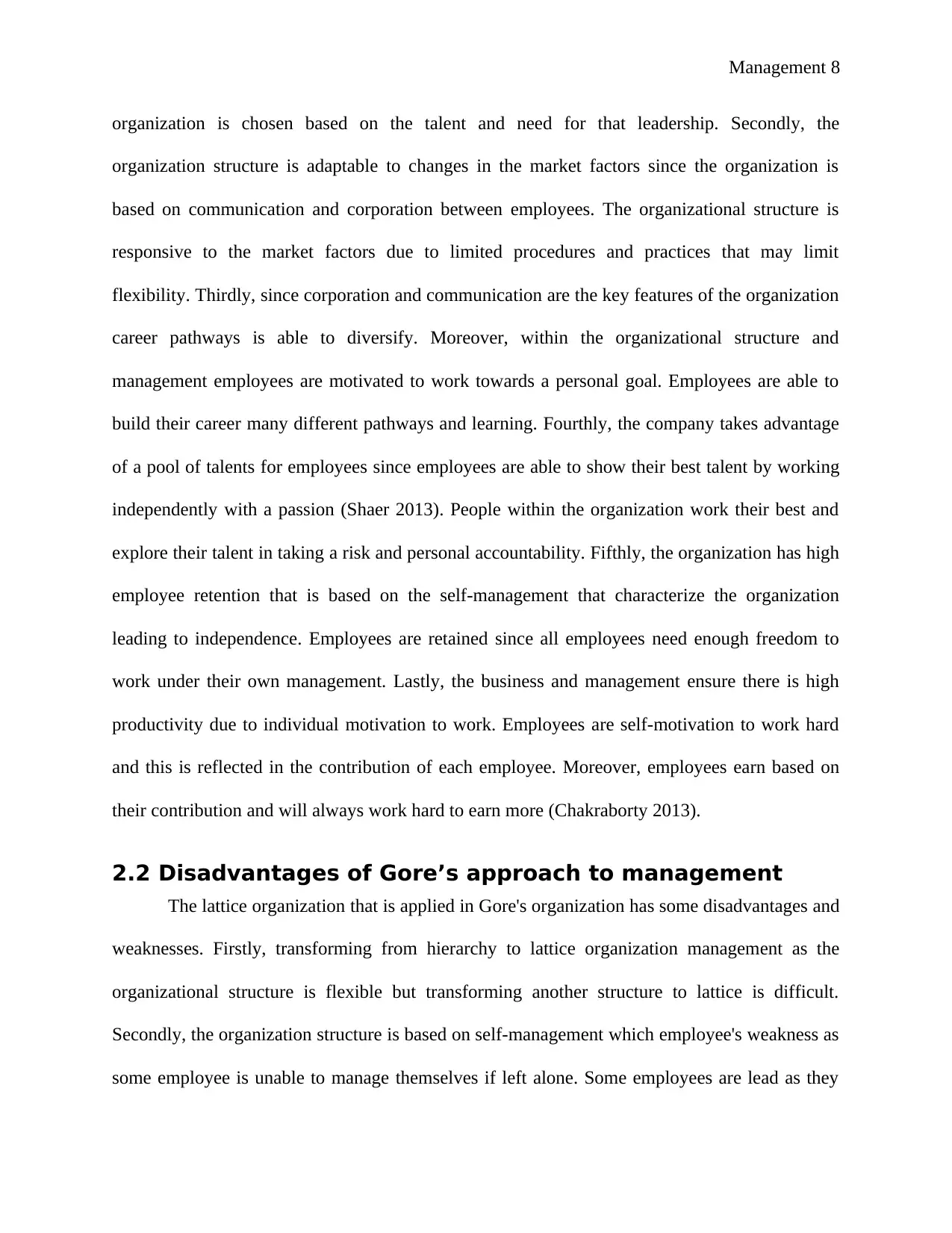
Management 8
organization is chosen based on the talent and need for that leadership. Secondly, the
organization structure is adaptable to changes in the market factors since the organization is
based on communication and corporation between employees. The organizational structure is
responsive to the market factors due to limited procedures and practices that may limit
flexibility. Thirdly, since corporation and communication are the key features of the organization
career pathways is able to diversify. Moreover, within the organizational structure and
management employees are motivated to work towards a personal goal. Employees are able to
build their career many different pathways and learning. Fourthly, the company takes advantage
of a pool of talents for employees since employees are able to show their best talent by working
independently with a passion (Shaer 2013). People within the organization work their best and
explore their talent in taking a risk and personal accountability. Fifthly, the organization has high
employee retention that is based on the self-management that characterize the organization
leading to independence. Employees are retained since all employees need enough freedom to
work under their own management. Lastly, the business and management ensure there is high
productivity due to individual motivation to work. Employees are self-motivation to work hard
and this is reflected in the contribution of each employee. Moreover, employees earn based on
their contribution and will always work hard to earn more (Chakraborty 2013).
2.2 Disadvantages of Gore’s approach to management
The lattice organization that is applied in Gore's organization has some disadvantages and
weaknesses. Firstly, transforming from hierarchy to lattice organization management as the
organizational structure is flexible but transforming another structure to lattice is difficult.
Secondly, the organization structure is based on self-management which employee's weakness as
some employee is unable to manage themselves if left alone. Some employees are lead as they
organization is chosen based on the talent and need for that leadership. Secondly, the
organization structure is adaptable to changes in the market factors since the organization is
based on communication and corporation between employees. The organizational structure is
responsive to the market factors due to limited procedures and practices that may limit
flexibility. Thirdly, since corporation and communication are the key features of the organization
career pathways is able to diversify. Moreover, within the organizational structure and
management employees are motivated to work towards a personal goal. Employees are able to
build their career many different pathways and learning. Fourthly, the company takes advantage
of a pool of talents for employees since employees are able to show their best talent by working
independently with a passion (Shaer 2013). People within the organization work their best and
explore their talent in taking a risk and personal accountability. Fifthly, the organization has high
employee retention that is based on the self-management that characterize the organization
leading to independence. Employees are retained since all employees need enough freedom to
work under their own management. Lastly, the business and management ensure there is high
productivity due to individual motivation to work. Employees are self-motivation to work hard
and this is reflected in the contribution of each employee. Moreover, employees earn based on
their contribution and will always work hard to earn more (Chakraborty 2013).
2.2 Disadvantages of Gore’s approach to management
The lattice organization that is applied in Gore's organization has some disadvantages and
weaknesses. Firstly, transforming from hierarchy to lattice organization management as the
organizational structure is flexible but transforming another structure to lattice is difficult.
Secondly, the organization structure is based on self-management which employee's weakness as
some employee is unable to manage themselves if left alone. Some employees are lead as they
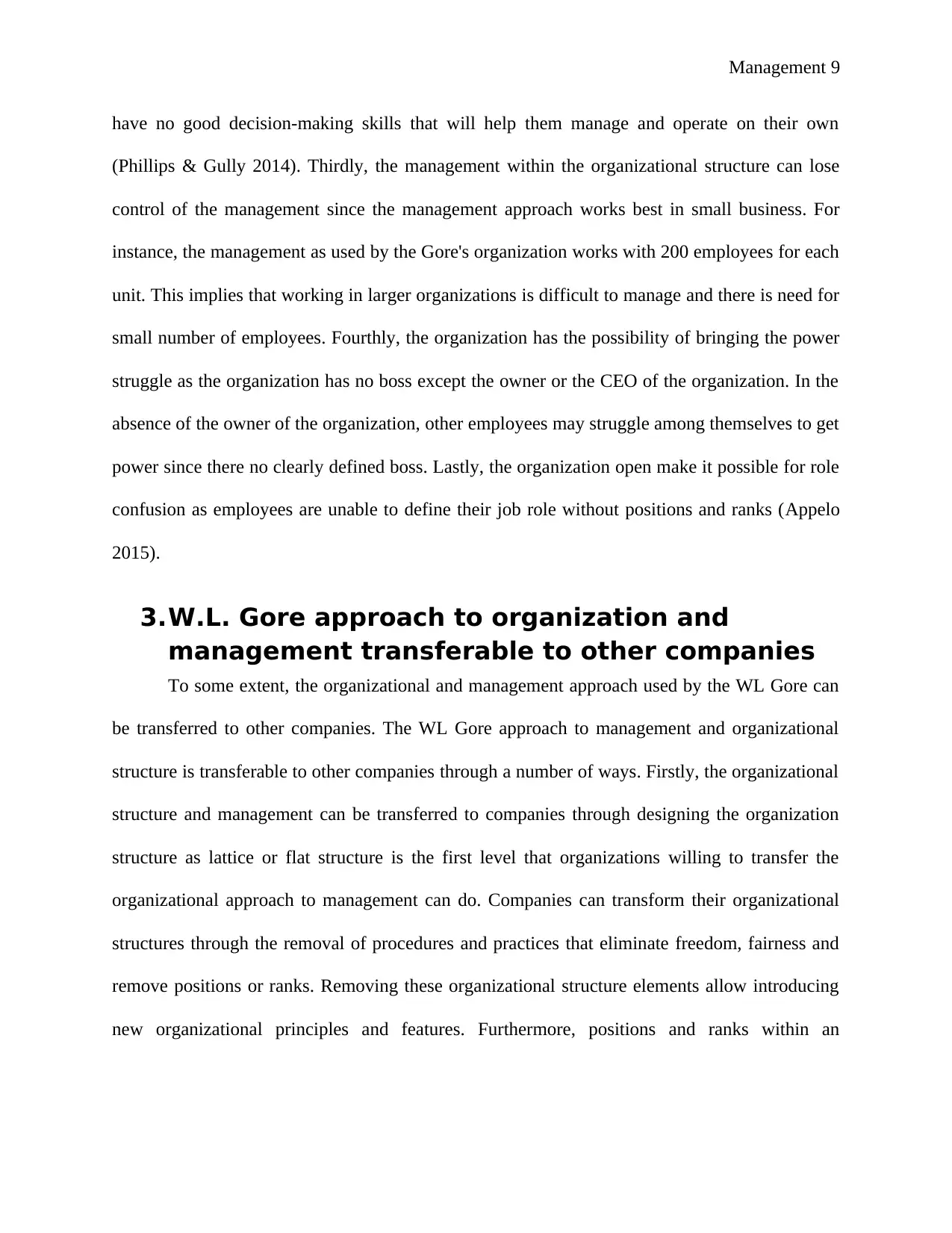
Management 9
have no good decision-making skills that will help them manage and operate on their own
(Phillips & Gully 2014). Thirdly, the management within the organizational structure can lose
control of the management since the management approach works best in small business. For
instance, the management as used by the Gore's organization works with 200 employees for each
unit. This implies that working in larger organizations is difficult to manage and there is need for
small number of employees. Fourthly, the organization has the possibility of bringing the power
struggle as the organization has no boss except the owner or the CEO of the organization. In the
absence of the owner of the organization, other employees may struggle among themselves to get
power since there no clearly defined boss. Lastly, the organization open make it possible for role
confusion as employees are unable to define their job role without positions and ranks (Appelo
2015).
3.W.L. Gore approach to organization and
management transferable to other companies
To some extent, the organizational and management approach used by the WL Gore can
be transferred to other companies. The WL Gore approach to management and organizational
structure is transferable to other companies through a number of ways. Firstly, the organizational
structure and management can be transferred to companies through designing the organization
structure as lattice or flat structure is the first level that organizations willing to transfer the
organizational approach to management can do. Companies can transform their organizational
structures through the removal of procedures and practices that eliminate freedom, fairness and
remove positions or ranks. Removing these organizational structure elements allow introducing
new organizational principles and features. Furthermore, positions and ranks within an
have no good decision-making skills that will help them manage and operate on their own
(Phillips & Gully 2014). Thirdly, the management within the organizational structure can lose
control of the management since the management approach works best in small business. For
instance, the management as used by the Gore's organization works with 200 employees for each
unit. This implies that working in larger organizations is difficult to manage and there is need for
small number of employees. Fourthly, the organization has the possibility of bringing the power
struggle as the organization has no boss except the owner or the CEO of the organization. In the
absence of the owner of the organization, other employees may struggle among themselves to get
power since there no clearly defined boss. Lastly, the organization open make it possible for role
confusion as employees are unable to define their job role without positions and ranks (Appelo
2015).
3.W.L. Gore approach to organization and
management transferable to other companies
To some extent, the organizational and management approach used by the WL Gore can
be transferred to other companies. The WL Gore approach to management and organizational
structure is transferable to other companies through a number of ways. Firstly, the organizational
structure and management can be transferred to companies through designing the organization
structure as lattice or flat structure is the first level that organizations willing to transfer the
organizational approach to management can do. Companies can transform their organizational
structures through the removal of procedures and practices that eliminate freedom, fairness and
remove positions or ranks. Removing these organizational structure elements allow introducing
new organizational principles and features. Furthermore, positions and ranks within an
⊘ This is a preview!⊘
Do you want full access?
Subscribe today to unlock all pages.

Trusted by 1+ million students worldwide
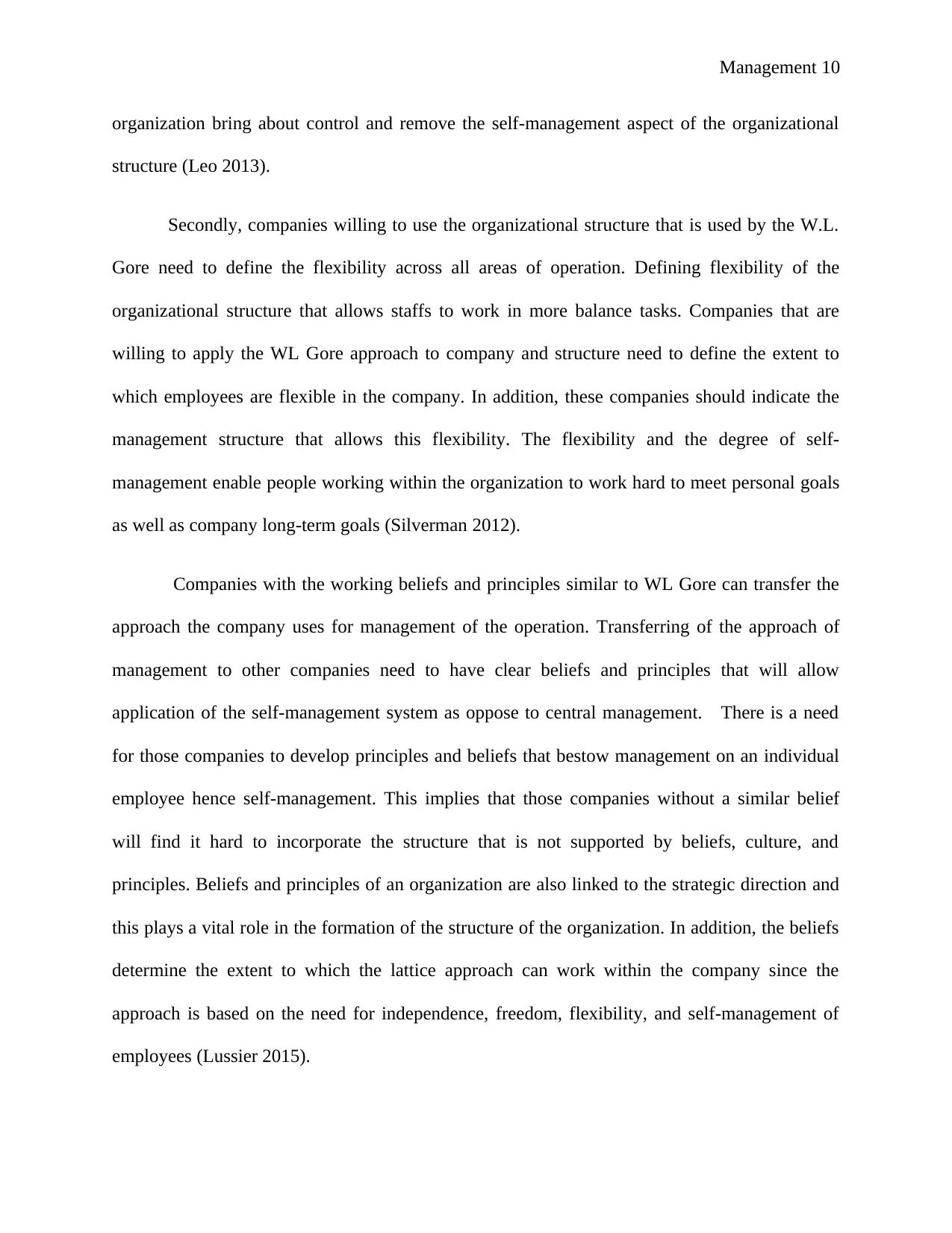
Management 10
organization bring about control and remove the self-management aspect of the organizational
structure (Leo 2013).
Secondly, companies willing to use the organizational structure that is used by the W.L.
Gore need to define the flexibility across all areas of operation. Defining flexibility of the
organizational structure that allows staffs to work in more balance tasks. Companies that are
willing to apply the WL Gore approach to company and structure need to define the extent to
which employees are flexible in the company. In addition, these companies should indicate the
management structure that allows this flexibility. The flexibility and the degree of self-
management enable people working within the organization to work hard to meet personal goals
as well as company long-term goals (Silverman 2012).
Companies with the working beliefs and principles similar to WL Gore can transfer the
approach the company uses for management of the operation. Transferring of the approach of
management to other companies need to have clear beliefs and principles that will allow
application of the self-management system as oppose to central management. There is a need
for those companies to develop principles and beliefs that bestow management on an individual
employee hence self-management. This implies that those companies without a similar belief
will find it hard to incorporate the structure that is not supported by beliefs, culture, and
principles. Beliefs and principles of an organization are also linked to the strategic direction and
this plays a vital role in the formation of the structure of the organization. In addition, the beliefs
determine the extent to which the lattice approach can work within the company since the
approach is based on the need for independence, freedom, flexibility, and self-management of
employees (Lussier 2015).
organization bring about control and remove the self-management aspect of the organizational
structure (Leo 2013).
Secondly, companies willing to use the organizational structure that is used by the W.L.
Gore need to define the flexibility across all areas of operation. Defining flexibility of the
organizational structure that allows staffs to work in more balance tasks. Companies that are
willing to apply the WL Gore approach to company and structure need to define the extent to
which employees are flexible in the company. In addition, these companies should indicate the
management structure that allows this flexibility. The flexibility and the degree of self-
management enable people working within the organization to work hard to meet personal goals
as well as company long-term goals (Silverman 2012).
Companies with the working beliefs and principles similar to WL Gore can transfer the
approach the company uses for management of the operation. Transferring of the approach of
management to other companies need to have clear beliefs and principles that will allow
application of the self-management system as oppose to central management. There is a need
for those companies to develop principles and beliefs that bestow management on an individual
employee hence self-management. This implies that those companies without a similar belief
will find it hard to incorporate the structure that is not supported by beliefs, culture, and
principles. Beliefs and principles of an organization are also linked to the strategic direction and
this plays a vital role in the formation of the structure of the organization. In addition, the beliefs
determine the extent to which the lattice approach can work within the company since the
approach is based on the need for independence, freedom, flexibility, and self-management of
employees (Lussier 2015).
Paraphrase This Document
Need a fresh take? Get an instant paraphrase of this document with our AI Paraphraser
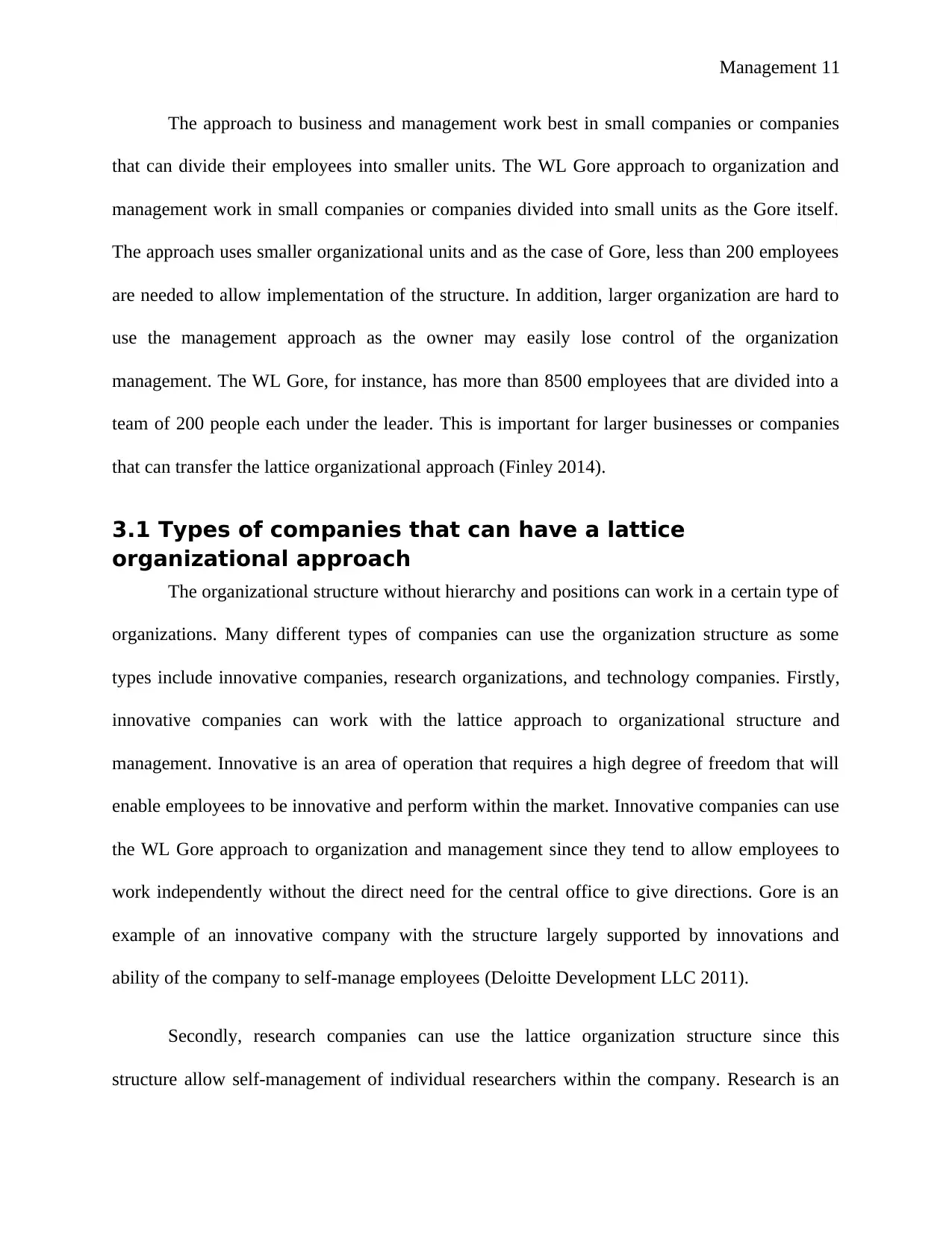
Management 11
The approach to business and management work best in small companies or companies
that can divide their employees into smaller units. The WL Gore approach to organization and
management work in small companies or companies divided into small units as the Gore itself.
The approach uses smaller organizational units and as the case of Gore, less than 200 employees
are needed to allow implementation of the structure. In addition, larger organization are hard to
use the management approach as the owner may easily lose control of the organization
management. The WL Gore, for instance, has more than 8500 employees that are divided into a
team of 200 people each under the leader. This is important for larger businesses or companies
that can transfer the lattice organizational approach (Finley 2014).
3.1 Types of companies that can have a lattice
organizational approach
The organizational structure without hierarchy and positions can work in a certain type of
organizations. Many different types of companies can use the organization structure as some
types include innovative companies, research organizations, and technology companies. Firstly,
innovative companies can work with the lattice approach to organizational structure and
management. Innovative is an area of operation that requires a high degree of freedom that will
enable employees to be innovative and perform within the market. Innovative companies can use
the WL Gore approach to organization and management since they tend to allow employees to
work independently without the direct need for the central office to give directions. Gore is an
example of an innovative company with the structure largely supported by innovations and
ability of the company to self-manage employees (Deloitte Development LLC 2011).
Secondly, research companies can use the lattice organization structure since this
structure allow self-management of individual researchers within the company. Research is an
The approach to business and management work best in small companies or companies
that can divide their employees into smaller units. The WL Gore approach to organization and
management work in small companies or companies divided into small units as the Gore itself.
The approach uses smaller organizational units and as the case of Gore, less than 200 employees
are needed to allow implementation of the structure. In addition, larger organization are hard to
use the management approach as the owner may easily lose control of the organization
management. The WL Gore, for instance, has more than 8500 employees that are divided into a
team of 200 people each under the leader. This is important for larger businesses or companies
that can transfer the lattice organizational approach (Finley 2014).
3.1 Types of companies that can have a lattice
organizational approach
The organizational structure without hierarchy and positions can work in a certain type of
organizations. Many different types of companies can use the organization structure as some
types include innovative companies, research organizations, and technology companies. Firstly,
innovative companies can work with the lattice approach to organizational structure and
management. Innovative is an area of operation that requires a high degree of freedom that will
enable employees to be innovative and perform within the market. Innovative companies can use
the WL Gore approach to organization and management since they tend to allow employees to
work independently without the direct need for the central office to give directions. Gore is an
example of an innovative company with the structure largely supported by innovations and
ability of the company to self-manage employees (Deloitte Development LLC 2011).
Secondly, research companies can use the lattice organization structure since this
structure allow self-management of individual researchers within the company. Research is an
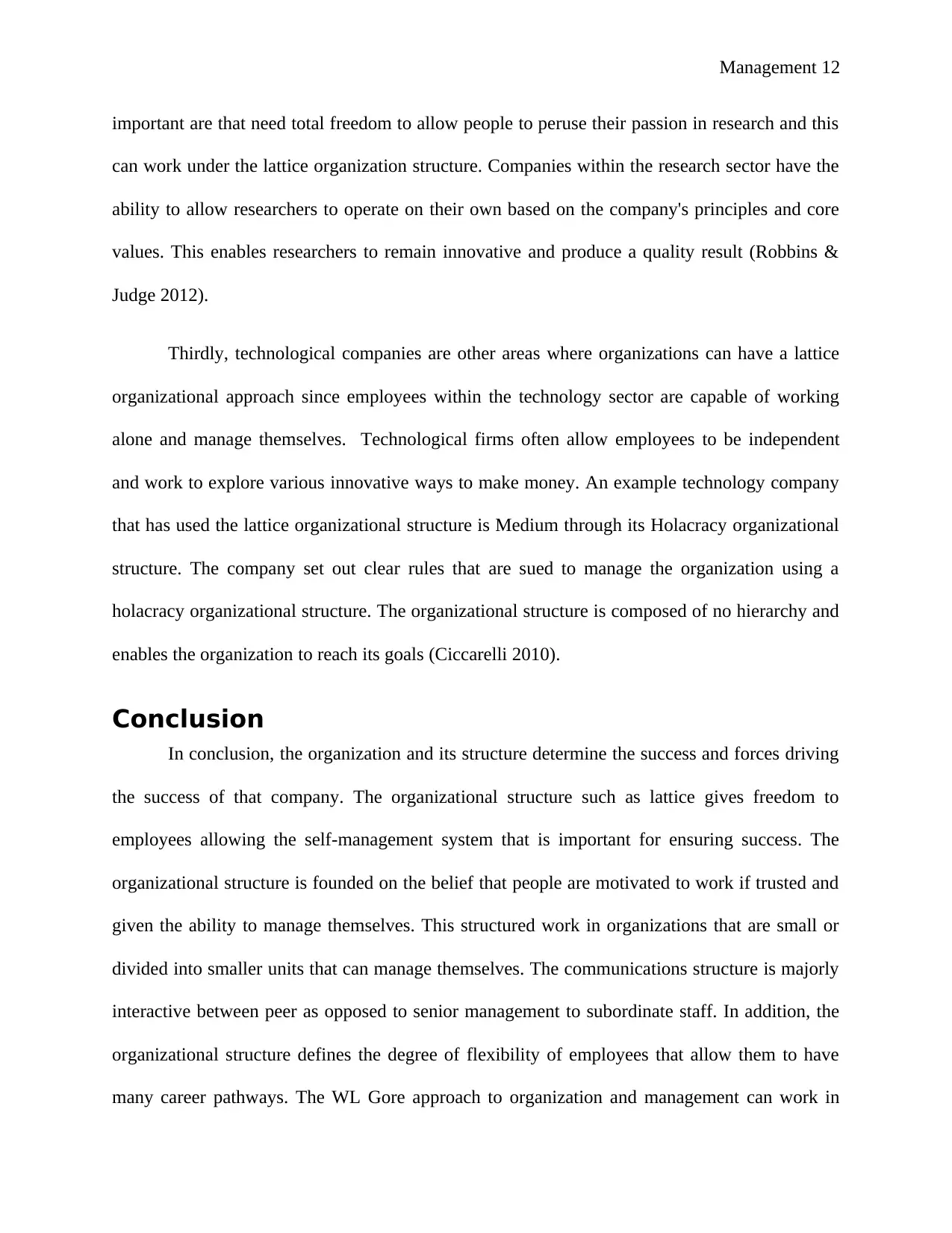
Management 12
important are that need total freedom to allow people to peruse their passion in research and this
can work under the lattice organization structure. Companies within the research sector have the
ability to allow researchers to operate on their own based on the company's principles and core
values. This enables researchers to remain innovative and produce a quality result (Robbins &
Judge 2012).
Thirdly, technological companies are other areas where organizations can have a lattice
organizational approach since employees within the technology sector are capable of working
alone and manage themselves. Technological firms often allow employees to be independent
and work to explore various innovative ways to make money. An example technology company
that has used the lattice organizational structure is Medium through its Holacracy organizational
structure. The company set out clear rules that are sued to manage the organization using a
holacracy organizational structure. The organizational structure is composed of no hierarchy and
enables the organization to reach its goals (Ciccarelli 2010).
Conclusion
In conclusion, the organization and its structure determine the success and forces driving
the success of that company. The organizational structure such as lattice gives freedom to
employees allowing the self-management system that is important for ensuring success. The
organizational structure is founded on the belief that people are motivated to work if trusted and
given the ability to manage themselves. This structured work in organizations that are small or
divided into smaller units that can manage themselves. The communications structure is majorly
interactive between peer as opposed to senior management to subordinate staff. In addition, the
organizational structure defines the degree of flexibility of employees that allow them to have
many career pathways. The WL Gore approach to organization and management can work in
important are that need total freedom to allow people to peruse their passion in research and this
can work under the lattice organization structure. Companies within the research sector have the
ability to allow researchers to operate on their own based on the company's principles and core
values. This enables researchers to remain innovative and produce a quality result (Robbins &
Judge 2012).
Thirdly, technological companies are other areas where organizations can have a lattice
organizational approach since employees within the technology sector are capable of working
alone and manage themselves. Technological firms often allow employees to be independent
and work to explore various innovative ways to make money. An example technology company
that has used the lattice organizational structure is Medium through its Holacracy organizational
structure. The company set out clear rules that are sued to manage the organization using a
holacracy organizational structure. The organizational structure is composed of no hierarchy and
enables the organization to reach its goals (Ciccarelli 2010).
Conclusion
In conclusion, the organization and its structure determine the success and forces driving
the success of that company. The organizational structure such as lattice gives freedom to
employees allowing the self-management system that is important for ensuring success. The
organizational structure is founded on the belief that people are motivated to work if trusted and
given the ability to manage themselves. This structured work in organizations that are small or
divided into smaller units that can manage themselves. The communications structure is majorly
interactive between peer as opposed to senior management to subordinate staff. In addition, the
organizational structure defines the degree of flexibility of employees that allow them to have
many career pathways. The WL Gore approach to organization and management can work in
⊘ This is a preview!⊘
Do you want full access?
Subscribe today to unlock all pages.

Trusted by 1+ million students worldwide
1 out of 14
Related Documents
Your All-in-One AI-Powered Toolkit for Academic Success.
+13062052269
info@desklib.com
Available 24*7 on WhatsApp / Email
![[object Object]](/_next/static/media/star-bottom.7253800d.svg)
Unlock your academic potential
Copyright © 2020–2025 A2Z Services. All Rights Reserved. Developed and managed by ZUCOL.




